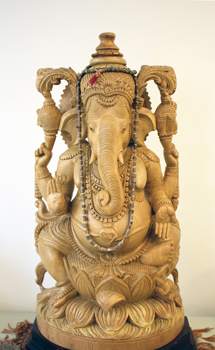
象神有好多有趣的故事,Lars老師在祂身上獲得了不少啟發,也想分享給練習瑜珈的你~~
Ganapati象神
印度神祇和神話很能引發想像,也很有吸引力,富含了象徵符號、戲劇化的故事,以及可以應用在我們生命旅程中的智慧。其中,我很喜歡象神的故事,半人半象。而他的象頭是怎麼來的呢?這個有趣的故事,我們就留到下次吧。
我們透過吟唱象神,祈求除去阻礙,獲得成功,所以能在任何計畫開始之前進行。當我在2007年參與Paul Dallaghan師資培訓課程時,每天早上站在墊上練習瑜珈之前,我們會一起吟唱這首梵頌。我結結巴巴地唱著梵文,發現這還真有點挑戰。但就像許多事情,練習是關鍵。下一個挑戰則是深思它和反思它的意義。我們能做的第一步是先知道你的課題是什麼,然後以開放的心祈求成功。當我們開放接受幫助,有時候它就會像魔術般出現了。而有些時候,我們只是需要離開自認為的道路,世間事以一種奇特和神奇的方式在運作,我們的心智也是如此。
頌文如下:
Vakratunda Mahakaya
Kotisurya Samaprabha
Nirvighnam Kurume Deva
Sarvakaryeshu Sarvada
象神 有著象鼻和大大的身軀
光芒像是千萬顆太陽
我每日向你祈求
保佑我成功
沒有阻礙
象神出現時常手拿各種工具,這些工具都是象徵符號,用以指引我們努力的方向。我們可以巧妙地使用這些工具來處理阻礙。
但,象神不總是以同樣的面貌出現,有時候祂會帶著不同的工具,有時只有一支象牙,有時兩支,就連梵頌內容在印度隨著區域不同,也會有些微不同。
大肚子
消化生命所給予我們的能力,把營養和廢物區分開來。勇敢的完全投入生命經驗之中,不論我們認為它是好的經驗,還是壞的?當生命不如我們所預期的發展時,保持開放,看看我們能從這經驗中學到什麼?讓經驗進來,順著生命前進。不公平的事情會發生,就克服它吧~有時候,禮物會偽裝成不是禮物。
小眼睛
專注。專注在你正在做的事情。好奇地觀察,同時注意細節和全貌,試著觀察阻礙是什麼,然後了解它。
大耳朵
成為真正的好聽眾。聽懂,而不是為回應而回應。深入的聆聽是與當下保持連結的好方法。聆聽他人、聆聽生命、聆聽你的心。
小嘴巴
少即是多。太多的嘰嘰喳喳意味著分心,通常只是腦袋裡猴子們的演出戲碼。有智慧地使用語言,當我們有智慧地使用它時,它是很有用的工具,讓我們以有意義且真誠的方式來溝通。
老鼠
老鼠常伴隨在象神身邊,牠是象神的坐騎。牠也是慾望的象徵。慾望是非常有力量的,可以驅使我們做很多事情,有時候會與我們「較好」的判斷衝突。在這點上,老鼠是有害的動物,且製造傷害。象神只有一個慾望,祂坐在慾望上面,並且控制它,同時,也允許慾望成為動力。你的慾望是什麼呢?請用你的心來選擇。
工具
象神常持斧頭現身。斧頭可以砍去不必要的執著。有時候最大的阻礙是來自我們執著於事情就該如我們所想的一樣。心智裡的猴子用在挑戰上是很有用的,但也可能製造很多問題,例如懷疑、恐懼、困擾、反感和偏見。也請小心,斧頭是危險的工具,請總是帶著仁慈使用它。你也會看到象神手拿繩子,繩可以用在很多地方,像是攀爬,或是拴牢船隻。每天帶著清明,深思何時、如何使用這些工具。
象鼻
象鼻是強壯的,可以把小樹連根拔起,也可以優雅地撿起一顆蛋。強壯而柔軟。在瑜珈墊上,我們可以練習,巧妙地培養力量和身形近乎沒有限制的柔軟度。將這經驗應用在練習心智上,心智與身體可以用來幫助我們克服障礙。
書
象神是藝術與科學的學者。祂閱讀和研究。兩大瑜珈經典《帕坦佳利瑜珈經》和《薄伽梵歌》,我鼓勵你兩本都讀,即使只讀一次。這兩本書有很多的智慧,能夠在生命旅程中幫助我們。
象牙
有時候,象神只有一支象牙。有一說法是祂折斷了其中一支(犧牲)來記錄祂的老師:聖人Wasa所口述的摩訶婆羅多。象神承諾不間斷的記錄直到任務完成,但中途祂的羽毛筆斷了,所以祂犧牲一支象牙來完成任務。多麼信守承諾呀。
你得到了哪些可以讓你專注在計畫上的啟發呢?
Indian deities and mythology can be a great source of fascination and intrigue. Rich with symbolism, dramatic stories and wisdom that can be applied to help us in our ongoing saga with call life. The story of Ganesha, the elephant god, is one of my favourites. Ganesha is half human and half elephant. How did he get his elephant head? That’s a fascinating tale for another time.
One can make a practice to chant to Ganesha to invite success in one’s work by removing our obstacles. This chant can be done at the commencement of, well, anything. During my 2007 TT with Paul Dallaghan, we chanted to Ganesha at the beginning of each morning prior to our yoga mat practice. I stumbled over the pronunciation and found chanting to be a bit challenging. But, as with many things, practice is the key. The next was to contemplate the chant and reflect upon its meaning. First know what your work is and ask with an open heart for success. When we are open to receive help sometimes it appears like magic out of nowhere. And at other times we just need to get out of our own way. The universe works in strange and amazing ways as does the mind.
Here’s the chant
Vakratunda Mahakaya
Kotisurya Samaprabha
Nirvighnam Kurume Deva
Sarvakaryeshu Sarvada
Ganesh, who with twisted trunk and big body,
is like 10 million suns in brightness
I call to you everyday
Grant me success always in my works
Let there be no obstacles
Ganesha is often shown with various tools that can serve as symbolism to guide us on our endeavours. These tools can be used skillfully to deal with obstacles. Ganesha doesn’t always appear the same. Sometimes with different tools and items. Sometimes with one tusk and other versions two. Even the chant varies slightly from region to region of India.
Large Stomach
The ability to digest what life gives and sort the nourishment out of the rubbish. Be courageous and brave to be fully in the entire experience of life whether we think it good or bad. When life doesn’t go as expected be open to see what the learning can be from the experience and let the experience go and move on with life. Unfair stuff happens get over it. Sometimes it can even be a gift in disguise.
Small Eyes
Concentration. Stay focussed on what you are doing. Observe with curiosity. Notice both the details and the big picture. Try to observe what the obstacle is and understand it.
Big Ears
Become a really good listener. Listen to understand rather than to just respond. Deep listening is a wonderful way to stay connected to the present moment. Listen to others. Listen to life. Listen to your heart.
Small Mouth
Less is more. Too much blah blah blah blah means less concentration and is usually just the monkeys in the mind putting on a show. Use words wisely. They can be helpful tool when used wisely to communicate in a meaningful and honest way.
Mouse
Ganesha is often pictured with a mouse. It turns out its his vehicle. Its a symbol for desire. Desires are very powerful and can drive us to do many things, sometimes against our better judgement. Mice reproduce to the point that they become a pest and cause damage. Ganesh has just one desire and he sits on it to keep it under control and also to allow that desire to be a driving force. What’s your desire? Choose with your heart.
Tools
Often Ganesha is shown with an axe. An axe can be used to cut attachments that no longer serve. Sometimes the biggest obstacle that arises is our attachment to the thinking of how things should be. The monkeys of the mind can be very useful when put to task but can create many things like doubt, fear, confusion, aversion, and prejudices. But be careful, an axe can be a dangerous tool. Always use it with kindness. The rope can be used for many things like climbing or to tether a boat. Meditate everyday knowing when and how to use these tools can be done with more clarity.
Trunk
An elephant’s trunk is strong and can uproot small trees and yet graceful enough to pick up a raw egg. Be strong and be flexible. On the yoga mat one can practice to skillfully build strength and flexibility putting the body into a nearly limitless array of shapes. With this direct experience we may invite ourselves to practice the same thing with our mind. Mind and body then can be used to help us overcome our obstacles.
Books
Ganesha is a scholar of both the arts and sciences. He reads and studies. Two major texts of yoga are The Yoga Sutras of Patanjali and The Bhagavad Gita. I encourage you to read them both, at least just once. There’s lots of wisdom in these books to help us on our journey.
Elephant Tusk
Sometimes Ganesha is pictured with just one tusk. One recount of this is that he broke off one tusk (sacrifice) to write the Mahabharata as was dictated by his teacher, the great sage Vyasa. He promised to write non-stop until the task was completed but his feather pen broke. So he sacrificed his tusk to complete his job. Such integrity to his word!
What’s your inspiration that keeps you focussed on your work?
你可能感興趣的文章
Loading…

 Posted in
Posted in  Tags:
Tags: 
